Two years into the pandemic, federal employee engagement drops in 2021 FEVS
Agencies’ return-to-office plans and a jump in hybrid workers play a role in the decrease for federal employees’ engagement and satisfaction scores in the 2021...
Change is the biggest constant for the federal workforce after two years in a pandemic that capsized government operations. Despite the upheaval, employee engagement remained relatively steady over the last year, dropping just one point between 2020 and 2021, from 72% down to 71%.
But other factors, like employees’ job and pay satisfaction, declined in 2021 compared to 2020. The overall index points for global satisfaction dropped as well, from 69% down to 64%.
One of the biggest changes for federal employees over the past year was a decrease in telework options, as more agencies made return-to-office plans. The latest data in the Federal Employee Viewpoint Survey (FEVS) for 2021, which the Office of Personnel Management released on April 28, reflect some of those changes.
OPM Director Kiran Ahuja highlighted federal employees’ “resilience” throughout 2021, as agencies adjusted to re-entry and moved some employees to hybrid work schedules.
“The OPM FEVS survey results highlight their resilience in the face of two years of unprecedented challenges, and show how they found creative solutions and leveraged workplace flexibilities to continue delivering results,” Ahuja stated in an April 28 press release.
Working hybrid schedules is becoming increasingly common for federal employees. In 2021, OPM reported an 11% drop in employees who entirely telework. Scaling up that type of work model can impact results as senior leaders and supervisors figure out what to do and how to handle it, OPM stated in the survey results.

Many of the results around worker satisfaction from 2021 compared with 2020 either flat-lined or dropped. Global satisfaction of FEVS respondents overall dropped in the past year, after seeing a significant jump in 2020. That measurement averages several satisfaction factors, including job and organization satisfaction.
The sharpest decline, though, was for pay satisfaction. That dropped 6% since 2020. Additionally, 2021 FEVS saw a 5% drop from 2020 for employees who feel that their workload is reasonable.
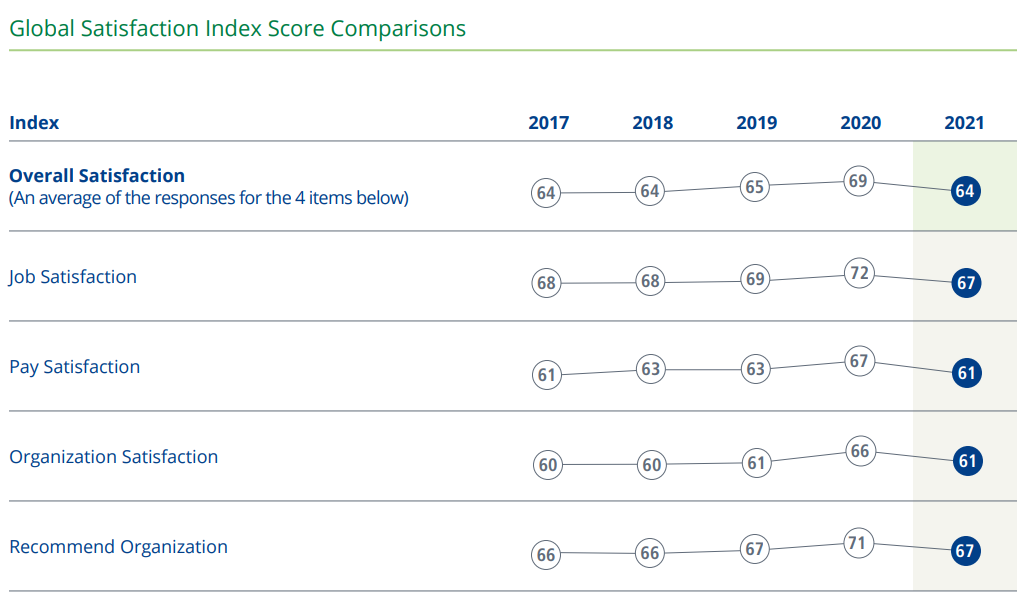
Results from 2021 FEVS are complicated by large-scale changes in the workplace, OPM stated. Opening up more in-person and hybrid work options may affect employees’ satisfaction with their work.
“The opportunities for telework have declined since the peak of the pandemic,” OPM wrote. “Telework is positively related to higher scores on employee engagement and global satisfaction and declines in telework could be linked to a decline in these scores.”
For job satisfaction, many employees gave lower scores during 2021 when asked about their coworkers responding effectively to changing priorities, dropping from 87% to 80%, as well as successfully collaborating, dropping from 82% to 76%.
The performance confidence index, a new section in 2020 that OPM continued for 2021, showed most scores either dropping or remaining flat.
Performance confidence combines things like meeting customer needs, producing high quality work and adapting to changing priorities. Ultimately, it looks at how employees perceive an agency’s ability to achieve goals and produce good work.
In that section, adapting to changing priorities had the biggest drop, down 7%. The only area that went up from 2020 was meeting the needs of customers, increasing by 2%.
Along with satisfaction and confidence, employee engagement also saw a decline from its 2020 FEVS standing.
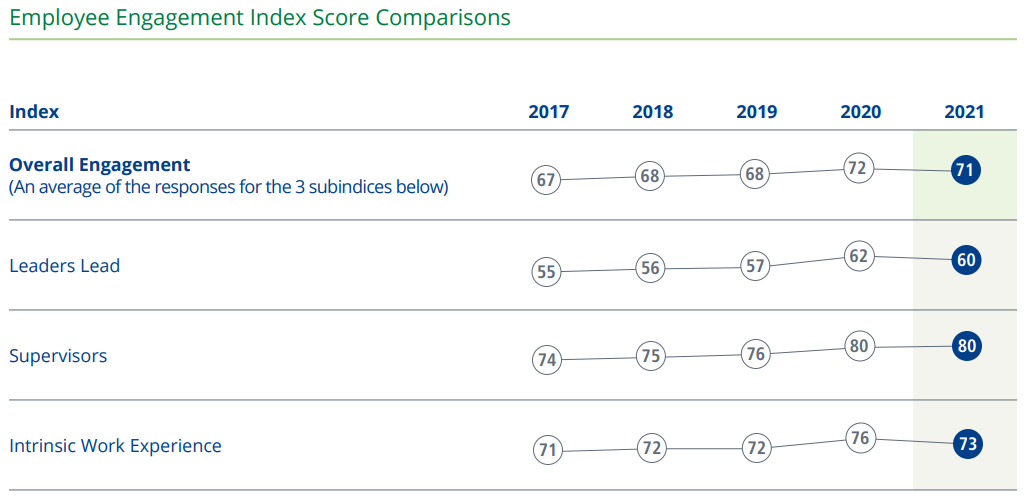
Response rates fell for all agency sizes across the board compared to 2020, dropping 10% for the government overall. For 2021, OPM sent the survey out to 865,425 employees and received a total of 292,520 responses, creating a response rate of 34%.
That’s down from about 44% of the federal workforce responding to the 2020 FEVS, and 43% responding in 2019.
OPM attributed that drop in part to a shorter turnaround for employees to submit their responses, as well as a delay in when the survey went out.
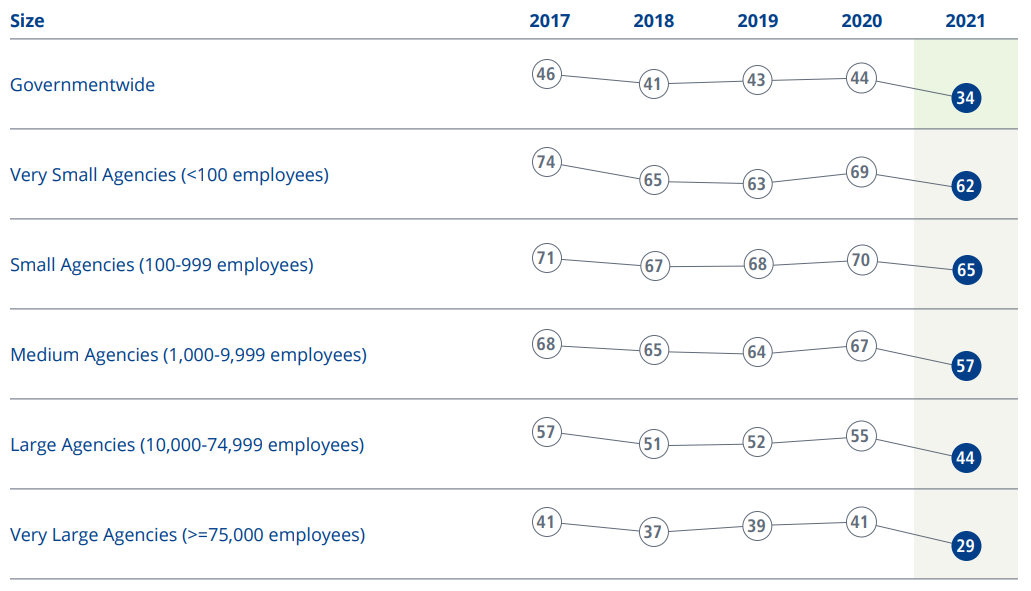
“The survey was fielded very late in the year, and only for five weeks,” OPM stated. “While canceling the survey for 2021 was discussed, OPM felt it was important to push forward with a survey to continue to collect valuable employee feedback. The very late and shortened timeframe was necessary in order to have a survey at all.”
Along with some of the more negative trends, OPM pointed to positive rates that employees responded about their agencies meeting the needs of the customer (88%), contributing positively to agency performance (86%), achieving goals (85%) and producing high-quality work (84%).
Across nearly all measures, smaller agencies performed better than larger ones. For example, in performance confidence, the governmentwide positivity rate was 85%, while small and very small agencies responded positively at 90% and 94% respectively.
For employee engagement, those percentages were in the 70s and upper 80s for very small agencies. Similarly, global satisfaction ranged in the upper 70s to 80% for the smallest government organizations.
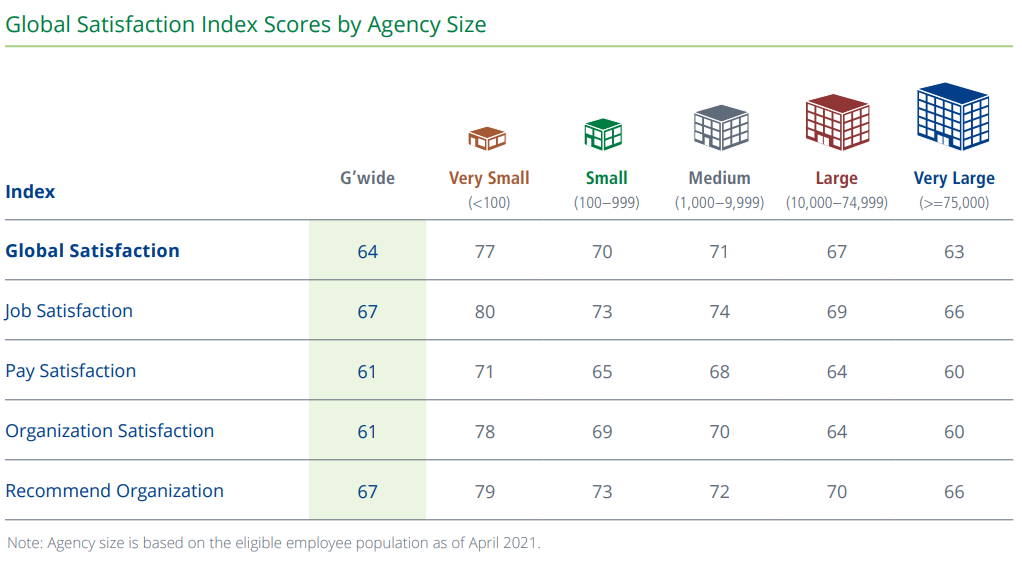
Perception overall for supervisors has been trending up since 2017, but between 2020 and 2021, it’s trending slightly downward.
Asking employees if supervisors supported their work-life balance and employee development, as well as listening to employees and treating them respectfully, all dropped by 1%.
But, 84% of respondents said their supervisors showed concern for health and safety. 79% said they can voice concerns to supervisors.
Direct supervisors fared better than agency senior leaders for the 2021 FEVS.
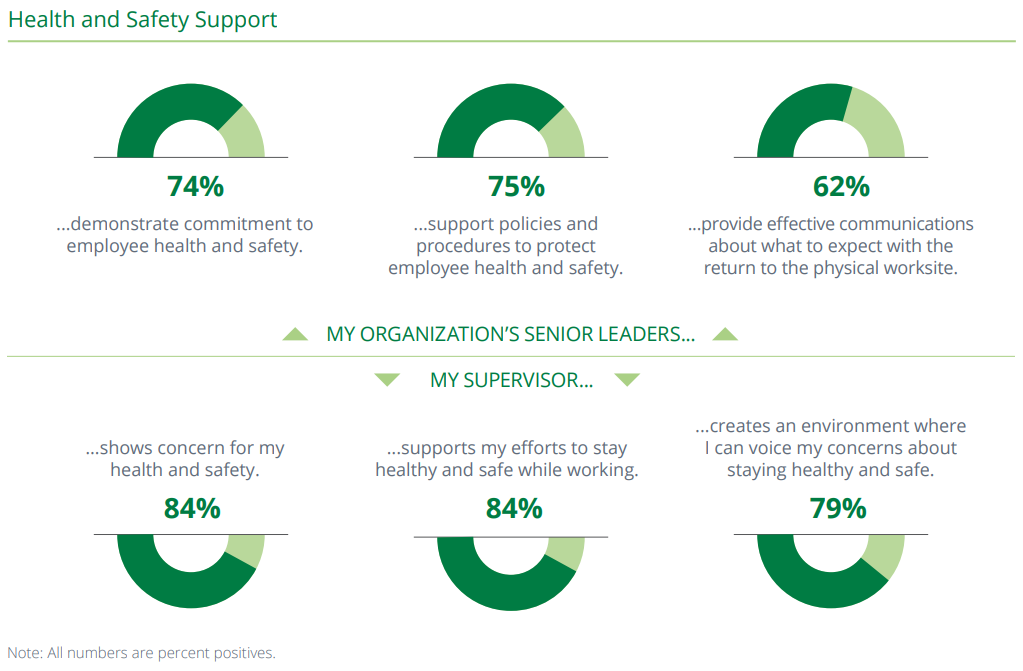
Respondents’ positive perceptions of senior leaders dropped off by 7% for categories relating to commitment to, and support of, employee health and safety.
In a new question for 2021, 62% of respondents said that their agency’s leaders provide effective communications about return-to-office plans.
Notably, when asked if they think agencies can respond well to future emergencies, respondents’ positive perceptions dropped 8%.
OPM warned not to compare these results too closely year over year. For both 2020 and 2021, the agency scaled back FEVS, for example in the number of questions and the scope of respondents.
“These include the timing and duration of administration, the sampling method, the reporting levels available and the inclusion of an optional pilot test of possible future survey content,” OPM stated.
Similar to 2020’s survey, OPM also reduced the number of reports and limited results to overall agency and first level units. Additionally, agency leaders were able to “opt in” temporary employees not previously considered eligible to receive a survey, OPM stated.
The pilot included questions on the White House’s diversity, equity, inclusion and accessibility executive order from June 2021.
Focusing on data and results from the 2021 FEVS will help inform how to implement the goals from the President’s Management Agenda, OPM wrote.
Along with that, the FEVS for 2022 will return to the typical late spring timeline for administering the survey. The agency will give employees the full six weeks to respond and open up the survey to a full census of agency participants. Then, OPM will release the results this fall.
OPM will also add more survey content to help agencies with specific ways to improve employee engagement in the coming years.
“Both the 2021 OPM FEVS survey and forthcoming revamped 2022 survey will provide critical data to inform agencies’ efforts to meet our important goals,” Ahuja said.
Copyright © 2025 Federal News Network. All rights reserved. This website is not intended for users located within the European Economic Area.
Drew Friedman is a workforce, pay and benefits reporter for Federal News Network.
Follow @dfriedmanWFED




